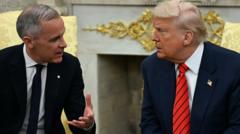On June 27, 2025, China’s Ministry of Commerce confirmed the details of a trade framework negotiated with the Trump administration, signaling a potential thaw in U.S.-China trade relations. The agreement entails China accelerating its exports of rare earth elements to the United States while Washington will ease its export controls on specific goods heading to China.
China and U.S. Reach Trade Agreement to Enhance Rare Earth Exports

China and U.S. Reach Trade Agreement to Enhance Rare Earth Exports
A new trade framework between China and the United States aims to facilitate the export of rare earth minerals and lift certain restrictions on goods.
The Ministry's statement outlined that China would expedite the review and approval process for exportation of controlled items, while the U.S. is expected to reciprocate by canceling some of the restrictions it enforced. Notably, Commerce Secretary Howard Lutnick hinted that these measures would align with President Trump's assertions of having signed a deal with China.
Recent diplomatic talks between both nations, including meetings in London and Geneva, have focused on stabilizing trade ties amid rising tensions characterized by the imposition of high tariffs and retaliatory measures by both nations. The deterioration in trade relations was underscored by a significant reduction in China's rare earth exports to the U.S., prompting the U.S. to impose its own restrictions on specific exports to China.
The discussions have continued against the backdrop of China’s recent crackdown on chemicals associated with fentanyl production, which seemed to be a gesture aimed at alleviating U.S. concerns over the opioid crisis.
Despite an apparent willingness from both countries to negotiate, significant challenges remain, particularly concerning the Trump administration's goals for China to significantly boost its imports of U.S. goods and to open its market further to American enterprises. Analysts suggest that while China maintains a firm stance in its trade war with the U.S., reaching a comprehensive agreement may ultimately benefit its sluggish economy, especially as it confronts the ongoing challenges related to a property crisis and consumer unease.
The path ahead for broader trade discussions remains uncertain, with expectations that both sides seek to build upon this initial agreement to address deeper economic issues.
**David Pierson covers Chinese foreign policy and China's economic and cultural engagement with the world, having reported for over two decades.**
Recent diplomatic talks between both nations, including meetings in London and Geneva, have focused on stabilizing trade ties amid rising tensions characterized by the imposition of high tariffs and retaliatory measures by both nations. The deterioration in trade relations was underscored by a significant reduction in China's rare earth exports to the U.S., prompting the U.S. to impose its own restrictions on specific exports to China.
The discussions have continued against the backdrop of China’s recent crackdown on chemicals associated with fentanyl production, which seemed to be a gesture aimed at alleviating U.S. concerns over the opioid crisis.
Despite an apparent willingness from both countries to negotiate, significant challenges remain, particularly concerning the Trump administration's goals for China to significantly boost its imports of U.S. goods and to open its market further to American enterprises. Analysts suggest that while China maintains a firm stance in its trade war with the U.S., reaching a comprehensive agreement may ultimately benefit its sluggish economy, especially as it confronts the ongoing challenges related to a property crisis and consumer unease.
The path ahead for broader trade discussions remains uncertain, with expectations that both sides seek to build upon this initial agreement to address deeper economic issues.
**David Pierson covers Chinese foreign policy and China's economic and cultural engagement with the world, having reported for over two decades.**





















